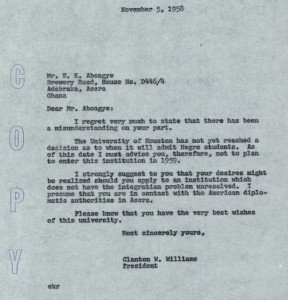
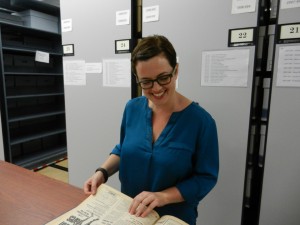
At work in the stacks.
We welcome Sara Craig to the University of Houston Special Collections, University Archives team.
This fall semester the University of Houston Special Collections added a new member, Sara Craig, to our team.
In the role of University Archives Student Assistant, Sara works part-time supporting the needs of the University Archives as well as other archival collections, assisting with reference questions, updating finding aids, assisting with collection management and shelving, accessioning materials, and helping to arrange and describe new collections.
Originally from South Carolina, Sara has studied engineering at the University of Southern California, and holds an Associate Degree in Library Information Technology. An art major here at the University of Houston, Sara enjoys working with her hands and looks forward to pursuing further education that will allow her to pursue a career in book repair and conservation. It may be in her genes.
With a horticulturist mother and a father working in cabinetry and furniture-making, Sara remembers, “I was the only four-year old girl I knew with a toolbox and a garden plot.” With that upbringing and a hands-on-DIY ethos, Sara meets the day-to-day surprises and challenges of working in the archives with aplomb. In her brief time here, she has already contributed to the publication of several finding aids such as the Minnie Fisher Cunningham: McArthur-Smith Research Papers, assisted with a collections shift in the archival stacks, rehoused oversized historical materials from the KUHF Collection, and co-curated the “UH Homecoming Through the Years” online exhibition.
We look forward to Sara’s continued expertise, insight, and support as the University Archives and Special Collections seek new ways to assist our patrons in their day-to-day research.
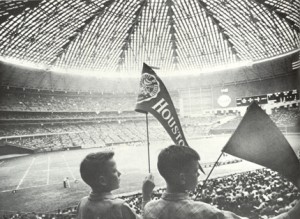
First Homecoming in the Astrodome, 1965 (from the online exhibit, “UH Homecoming Through the Years”)
It’s Homecoming Week, Cougars!
A week’s worth of activities and festivities will be capped off this weekend with Saturday’s football game against the Tulane University Green Wave. In honor of this special week, the University of Houston Special Collections is proud to present “UH Homecoming Through the Years,” an online exhibition curated by our own Matt Richardson and Sara Craig that traces the history of the tradition back to its origins in 1946.
Featuring visual histories of the Homecoming Court, Homecoming Game, and festivities that have traditionally centered around Homecoming Week down on Cullen Boulevard, “UH Homecoming Through the Years” pulls from a number of collections in our University Archives and related items. Daily Cougars and Houstonian yearbooks showcase some significant Homecoming Queen history, the UH Photographs Collection provides remarkable views of our traditions over time, and the Athletic Department Records remind us of some great homecoming victories that signified UH’s rise as an athletic as well as academic power.
As the celebrations of the week call all Cougars back home, be sure to spend some time with a virtual stroll through college days gone by with our newest online exhibit and be sure to visit Special Collections for a closer look at the University Archives.
Let’s follow recent posts about Kenneth Bentsen’s Philip G. Hoffman Hall (PGH), with a look at his Agnes Arnold Hall (1968) next door. Like PGH, Agnes Arnold is a good modern design and its success has much to do with Bentsen’s use of contrast. An important principle of architectural design, the contrast between thick and thin, heavy and light, solid and transparent enlivens a building’s form.
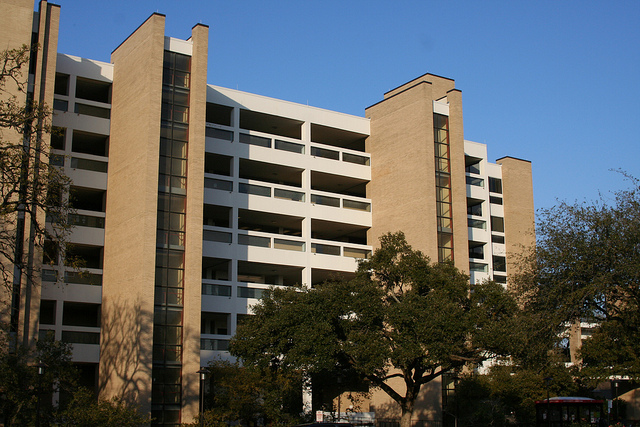
Kenneth E. Bentsen, Agnes Arnold Hall, University of Houston (1968), south elevation (Photo Eric E. Johnson, by permission)
At Agnes Arnold the vertical lines of the towers contrast with the horizontal lines of the stacked classroom levels. The texture and color of the brown brick towers contrasts with the smooth white spandrels and railings. The solid brick contrasts with the transparent glass. Agnes Arnold Hall is also effective because of its layered façade, which is much more sculptural than Bentsen’s very reserved PGH design. Here the architect achieves this sculptural effect by placing the corridors on the edge of the building and opening them to the outside. The surface is cut away and you can see deep within the building.
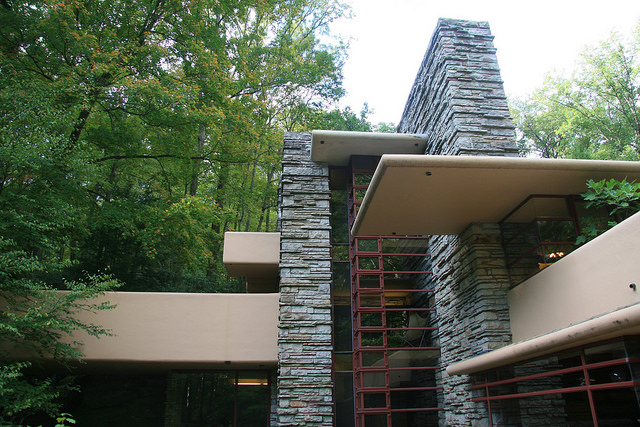
Frank Lloyd Wright, Fallingwater, Bear Run, PA (1936), detail. Photo J.P. Otto, all rights reserved.
You see these same formal principles at work in another successful modern design where contrasting lines, colors, and textures animate the façade of Frank Lloyd Wright’s famous house, “Fallingwater.”
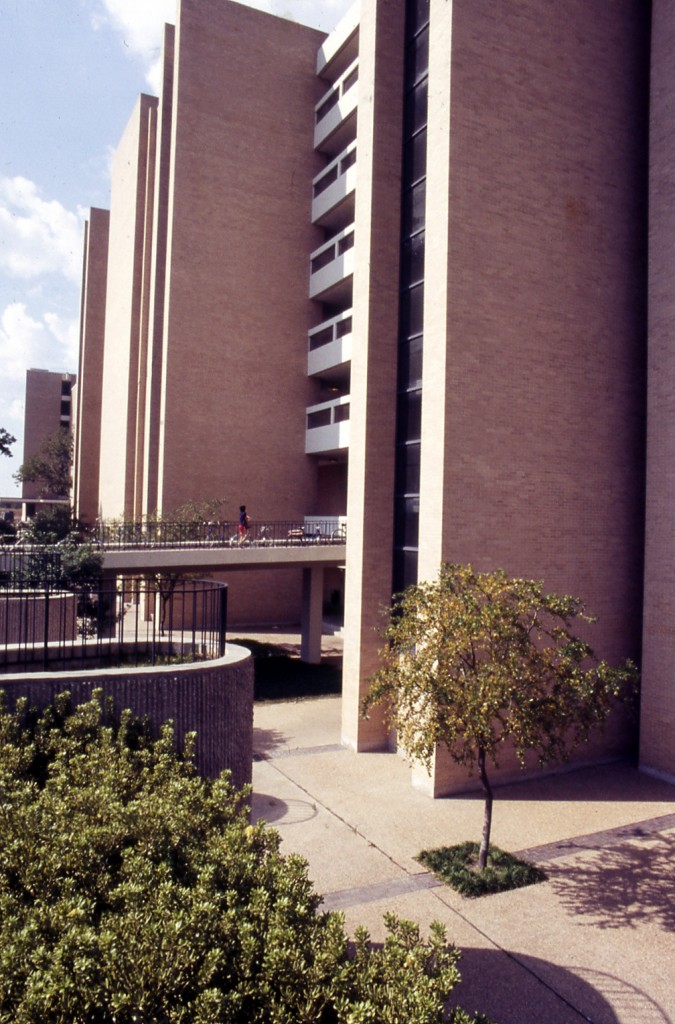
Agnes Arnold Hall is entered from a bridge over the basement courtyard. Kenneth E. Bentsen Architectural Papers
Architects are encouraged to design in three dimensions, not just two. They are intrigued by the idea of space that flows through the building vertically as well as horizontally. You see this in the three-level lobby of Agnes Arnold, where the ground floor is open not just to the level above but to the level below as well. In addition, the building is entered from the south over a dramatic bridge that spans the open courtyard at the basement level. From the street the building appears to rise from an open pit.
The Kenneth E. Bentsen Architectural Papers are housed in the library’s Special Collections department and are currently being processed. Pictures of Agnes Arnold Hall and other campus buildings are available in the University of Houston Buildings Collection of the UH Digital Library.
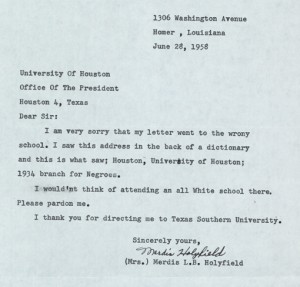
“I would’nt think of attending an all White school there. Please pardon me.” (detail of a letter from Merdis L.B. Holyfield to UH President, 1958, from the University of Houston Integration Records)
A number of new digital collections have been rolling out over at our Digital Library and if you blink, it’s been tough to keep up. Over the coming days we will publish some highlights, showcasing these new and exciting primary sources now made available to researchers, free from the constraints of reading room hours or the patron’s locale.
One collection new and of note? Check out the University of Houston Integration Records.
The University of Houston is rightly proud of its gender and ethnic diversity. Often touted as one of the most ethnically diverse research universities in the nation, Cougars come in all colors and creeds. The integration of the University’s athletics programs under coaches Guy V. Lewis and Bill Yeoman changed the face of collegiate athletics in the South and is thoroughly documented in Katherine Lopez’s Cougars of Any Color. The image of Lynn Eusan’s beaming smile in 1968, as she became the first black homecoming queen at a predominantly white university in the South, still looms large in our history and marked another step in UH’s legacy of integrated and equal.
However, this diversity and legacy did not happen by accident or overnight.
The University of Houston Integration Records document the early days of hand-wringing and tiptoeing around an issue that still confounded so much of the nation and, unresolved, threatened to tear communities apart. While violent opposition to integration plumbed new depths for history, particularly throughout the South, what resulted at UH were steady, incremental, and quiet steps, spearheaded by University Presidents Clanton C. Williams, A.D. Bruce, and Phillip G. Hoffman. Working with community leaders, University Administration would eventually oversee an admissions process that resulted in twenty black students being enrolled at UH in the spring of 1963.
By 1964, football and basketball illustrated the importance of intercollegiate athletics, as Elvin Hayes and Don Chaney were dominating the hardwood for Coach Guy V. Lewis and Warren McVea was gearing up to revolutionize the game in Coach Yeoman’s veer offense (all while enduring merciless and ugly epithets from fans of programs in the Deep South). The nation had been put on notice. A university, in the South and striving to become colorblind, was not only surviving but thriving by serving all the sons and daughters of Houston, and ultimately scholars the world over. In doing so, they have left us an inheritance of a virtual global village doing remarkable work on Cullen Boulevard.
Included in these University of Houston Integration Records are documents from the 1940s through the 1960s, with an emphasis on the ’50s and ’60s. Correspondence and internal memoranda from University Administration, as well as documents and letters related to the applications of prospective black students (both domestic and international) highlight the poignancy of the collection. The sheer absurdity of segregation laws and practices in the United States hits home as one reads President Williams’ flailing attempt in 1958 at an explanation to a Ghanaian student regarding the particulars of his denial of admission:
“I regret very much to state that there has been a misunderstanding on your part.” (detail of letter from UH President Clanton W. Williams to prospective student, E.K. Aboagye, 1958, from the University of Houston Integration Records)
I regret very much to state that there has been a misunderstanding on your part.
The University of Houston has not yet reached a decision as to when it will admit Negro students. As of this date I must advise you, therefore, not to plan to enter this institution in 1959.
I strongly suggest to you that your desires might be realized should you apply to an institution which does not have the integration problem unresolved. I presume that you are in contact with the American diplomatic authorities in Accra.
Needless to say, the University of Houston has come a long way since then, now embracing its diversity as a core value and strength.
Selections in the University of Houston Integration Records are pulled from the President’s Office Records in our University Archives. Original documents may be viewed in the Special Collections Reading Room during our normal research hours or on the Digital Library at your leisure.
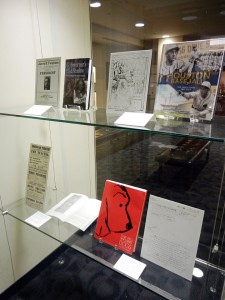
a new rotating, mini-exhibition of publications and projects produced in conjunction with research from the University of Houston Special Collections is now on display
The University of Houston Special Collections has begun a rotating exhibition showcasing highlights of publications and projects produced in conjunction with research from our collections. Located in the exhibit space adjacent to the Special Collections front door, in the Aristotle J. Economon, Hanneke Faber & Andrew J. Economon Elevator Lobby, “From Our Collections… Publications & Projects Featuring Research from the UH Libraries’ Special Collections,” shines a light on the fruits of research gathered from the rare books and archival collections preserved, safeguarded, and made available for study at the University of Houston.
With more than 7,000 linear feet of archival collections and over 100,000 rare books, the UH Special Collections provides daily research assistance to authors, filmmakers, artists, and patrons of all varieties. What they produce and share with us, enlightens, often breaks new ground, and rarely fails to astound.
Works and research currently featured include:
In the Governor’s Shadow: The True Story of Ma and Pa Ferguson, Carol O’Keefe Wilson (2014); featuring research from the Claude Elliott Texana Collection.
Houston Baseball: The Early Years 1861-1961, Mike Vance, editor (2014); featuring research from the George Fuermann “Texas and Houston” Collection and Houstonian Yearbooks.
“‘For the Relief of the Texians’: A Theatrical Benefit to Aid the Texas Revolution,” Pat Bozeman (2012); from Southwestern Historical Quarterly, featuring research from the Governor James V. Allred Papers.
The Big New Yorker Book of Dogs, The New Yorker Magazine (2012); featuring the short story “Chablis” by Donald Barthelme and research from the Donald Barthelme Literary Papers.
In addition to this new mini-exhibit, we pass along a gentle reminder to catch “LGBTQI Literature: Celebrated Classics and Contemporary Works,” currently viewing on the first floor of the M.D. Anderson Library. We hope you enjoy both of these exhibitions and look forward to sharing more in the future.
